Home » Construction Blogs (Page 2)
Category Archives: Construction Blogs
Inmate Sentenced for Conning Dealers into Selling Him $2.8M in Equipment

A federal inmate has been sentenced for fraudulently ordering $2.8 million worth of heavy equipment from six different dealers.
While serving a 20-year state prison sentence at Hays State Prison in Trion, Georgia, Damon Thomas Young used a contraband cellphone to con multiple heavy equipment dealers into selling him wheel loaders, skid steer loaders, an excavator, a horizontal grinder and dump trucks.
The 39-year-old inmate, using the alias Morgan Sylvia, claimed to be a purchasing agent for Chicago pharmaceutical company AbbVie for a new facility he said was being built in Ranger, Georgia. Once the equipment was obtained, he sold it on Craigslist.
Most of the dealers caught the fraud before shipment, but Young was successful in acquiring four pieces of equipment worth over $500,000.
“Young schemed to steal millions of dollars’ worth of heavy equipment while serving a sentence for assaulting a police officer,” says U.S. Attorney Kurt R. Erskine. “Inmates should not think that the crimes they commit from prison will go unpunished just because they are already incarcerated. As in this case, inmates who commit crimes from behind bars face additional federal prison time to be served after their state sentences end.”
On Nov. 30, Young was sentenced to seven years in prison, followed by three years of supervised release, according to the U.S. Attorney’s Office of the Northern District of Georgia. The court ordered that five years of the federal sentence run consecutively to the state sentence that Young is currently serving. His maximum possible release date from state prison is June 16, 2030.
Young has also been ordered to pay $30,000 in restitution to the online purchaser of the stolen equipment.
Did you miss our previous article…
https://constructionosa.org/?p=1140
2nd Day of Construction Gifts: This Grill Has a Cult-Like Following

Editor’s note: Each day until Christmas, Equipment World is featuring a new gift idea for the construction enthusiast in your life. Check back each day to our Gear section or subscribe to our Equipment World Daily newsletter to see each day’s new idea.
Make room on your patio, there’s a new grill in town. (Charcoal diehards, hear us out.) Flat-top grills have exploded in popularity over the past couple of years, but one brand has caught the most buzz.
The Blackstone Professional 36-Inch Flat Top Grill is perfect for any meal of the day. With 720 square inches of cooking area, you can serve up a hearty batch of hash browns and eggs at breakfast, juicy burgers at lunch and restaurant-style teppanyaki for dinner.
With a maximum temperature of 500 degrees Fahrenheit, this unit delivers 60,000 BTU of cooking power across four independently controlled burners. Additional features include a side shelf, bottom shelf and updated grease management system.
You can pick up a Blackstone at major retailers, including Walmart, Cabela’s and Home Depot or on Amazon for $349.
Check out yesterday’s gift:
1st Day of Construction Gifts: A Cool Watch Made of Bourbon Barrels
3rd Day of Construction Gifts: Stylish Sunglasses Certified for Safety

Editor’s note: Each day until Christmas, Equipment World is featuring a new gift idea for the construction enthusiast in your life. Check back each day to our Gear section or subscribe to our Equipment World Daily newsletter to see each day’s new idea.
Who says safety can’t be stylish? Wye Delta offers a wide range of ANSI-certified sunglasses with some surprising features.
The Conductor model comes with an adjustable nose pad to ensure a comfortable fit. A magnet on each side of the arms can hold small metal objects, like cotter pins or nails, keeping your hands (or mouth) free. The smoke lens reduce glare while maintaining true color perception.
According to Wye Delta, these glasses meet the ANSI Z87+ industrial standards for high-mass and high-velocity impact protection with no side shield needed.
This model and other ANSI-certified models can be purchased from the Wye Delta online store.
Check out yesterday’s gift idea:
2nd Day of Construction Gifts: This Grill Has a Cult-Like Following
Did you miss our previous article…
https://constructionosa.org/?p=1134
Technician of the Year: “If Something Breaks Down … I’m All Over It.”
As a child, Chase Snyder was fascinated with construction equipment.
He would watch the “There Goes a Truck” series over and over on the VCR, especially the episodes that focused on heavy equipment.
That love of equipment has stuck with Snyder. Now, he’s 26 and each day he’s working on big diesel machines as senior fleet technician for the Manatee County, Florida landfill. The bigger, the dirtier, the more challenging the job – the better.
“I prefer the landfill stuff,” Snyder says, when asked about his favorite equipment to work on. “A lot of people think that’s weird when I say that, because it’s typically the dirtiest, the nastiest. When you’ve got to go and clean them and crawl up in the belly pans, you never know what you’re going to encounter.
“But it doesn’t deter me. I just find it interesting what the machines are able to do.”
That attitude, his professionalism, his ability to save money by handling repairs in-house and his commitment to training have earned Snyder the top honor in his profession – the 2021 Technician of the Year Award by the Association of Equipment Management Professionals’ Education Foundation.

Chase Snyder prefers working on large, yellow iron at the Manatee County landfill.Courtesy of Manatee County
Growing up, Snyder fed his love of equipment by visiting his grandfather’s construction business. As he got older, he would also spend time with his other grandfather, who was a technician at a Ford dealership, restoring 1950s-era Fords. “I’d always be out there watching him and trying to help him tinker,” Snyder says.
In high school, he decided being a heavy-diesel technician was what he wanted to do. He saved up to buy a diesel pickup truck he could work on to prepare for his future career.
“When you’re younger and don’t have a lot of money, you’ve got to learn how to make stuff run and learn how things work, because you can’t have somebody fix it for you,” he says.
He learned mechanical repair on his truck by trial and error. He also got a job at a farm while in high school and performed basic maintenance on tractors.
When it came time for college, he got his associates degree. After that, he broke with family tradition of getting a four-year college degree and instead went to trade school.
“I wanted to get into heavy diesel just because I found it interesting,” he recalls. “But I had to go to school at night, because I was working full time during the day, and there’s no diesel program within an hour and a half drive of where I was living at the time. So I went at night for general automotive.”
While attending Manatee Technical College, he tried to work as a technician for some construction companies, but he didn’t have the diesel experience. But he was able to land a job with Sarasota County working on transit buses. He learned a lot to help him in his career. One longtime worker there was particularly generous with his knowledge.
“Luckily he took me under his wing and taught me a lot of some of the older-school tricks that still are relevant,” he says.
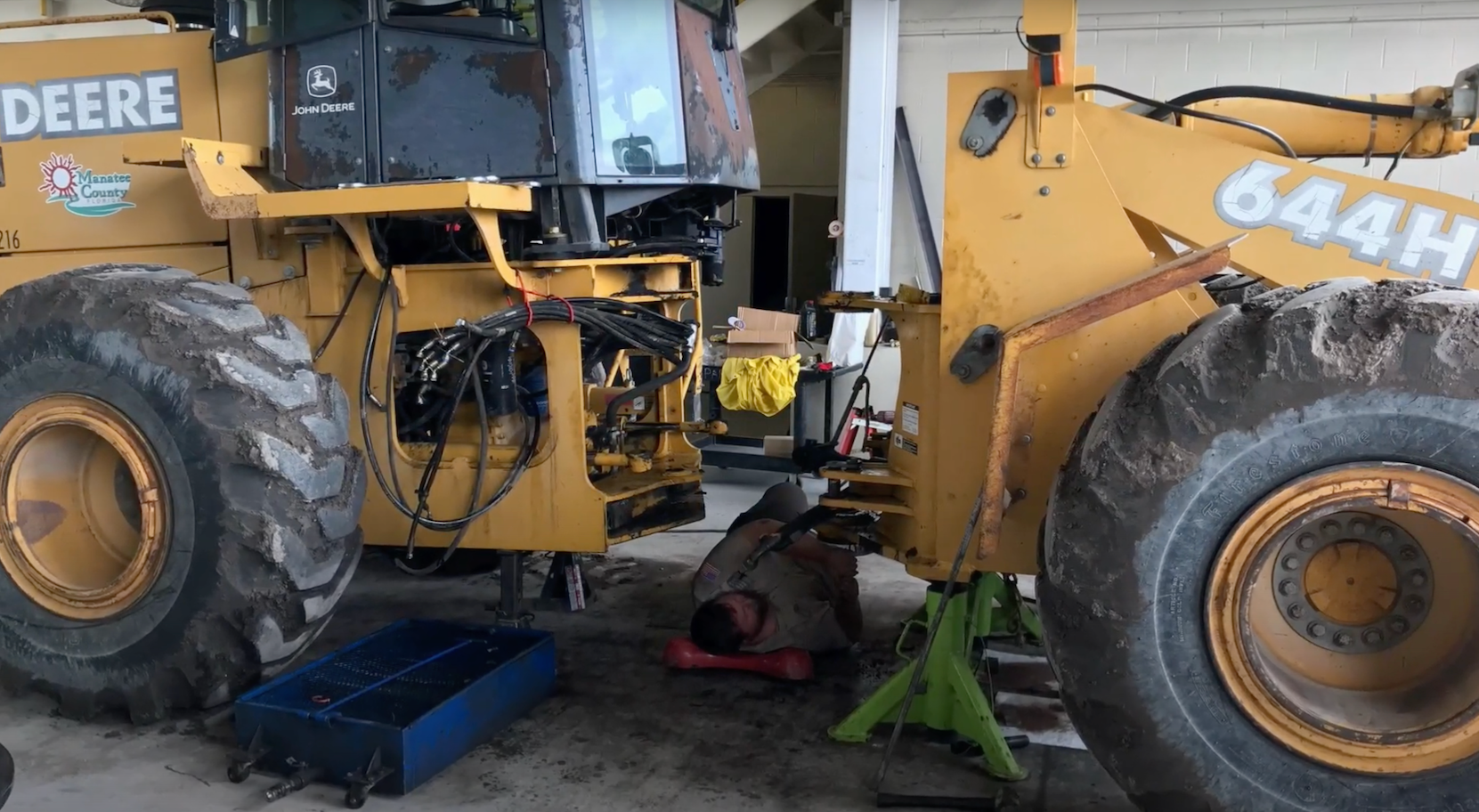
Chase Snyder prefers to tackle the challenging jobs.Courtesy of Manatee County
After graduation, he started working for Manatee County. At last, he was with the yellow iron he loved so much. The county has a 170-piece fleet, including heavy dozers, wheel loaders, excavators and massive landfill compactors.
His supervisor at the county landfill shop, David Alligood, won last year’s AEMP Technician of the Year Award. Snyder did not know Alligood before he came to work for Manatee County, but he had heard of him. When looking for work while in tech school, Snyder met the fleet manager for Sarasota County, who had also worked at Manatee County.
“And I met with him and he laughed, and he goes, ‘You remind me of this guy David that I hired about 10 years ago,’” Snyder recalls.
When he went to the job interview for Manatee County, Alligood was in the room.
“There were four or five of us in that room,” remembers Alligood. “And when he walked out, we all looked at each other. We’re like, ‘That’s probably the best interview we’ve ever had.’”
“I couldn’t believe it,” Alligood adds. “He was a dead ringer.”
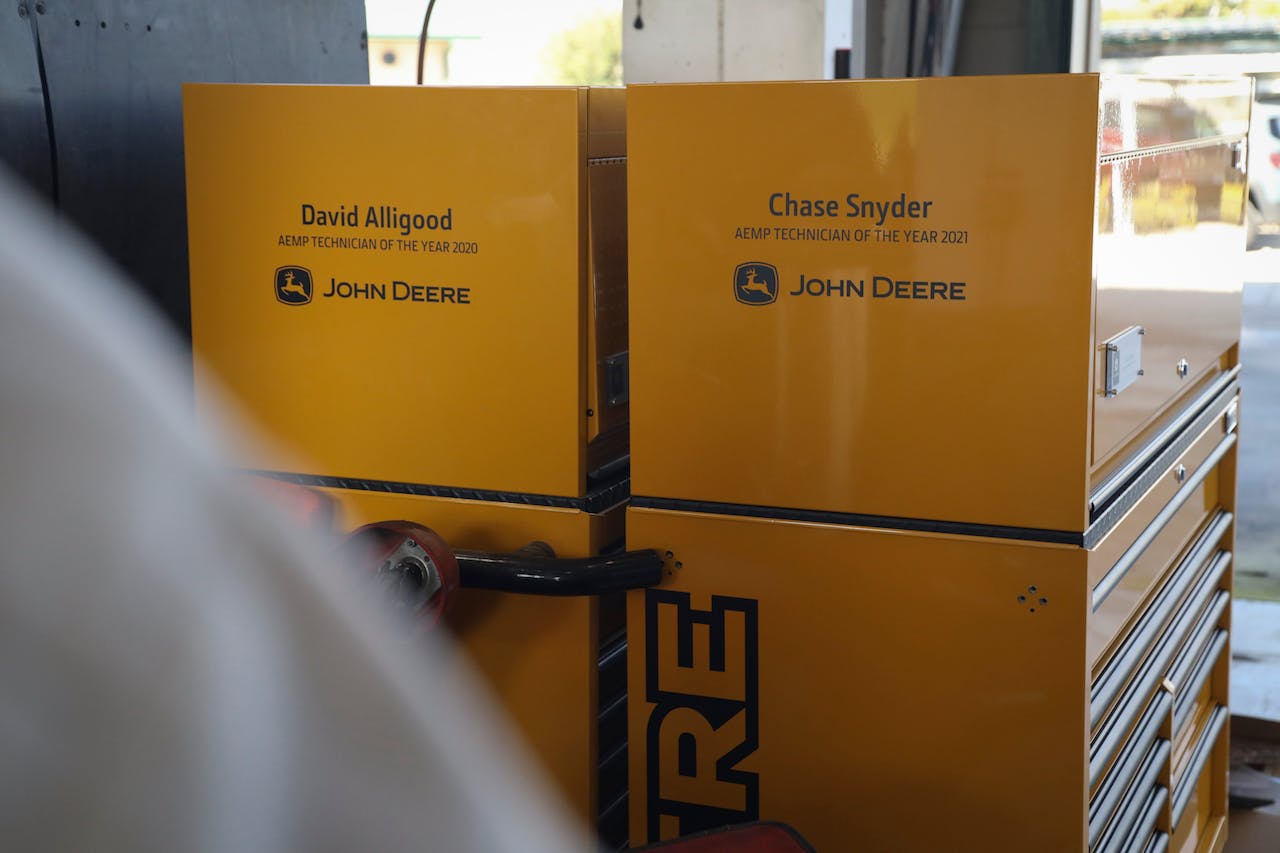
Back-to-back winners in Manatee County show their winning custom John Deere toolboxes side-by-side.Courtesy of Manatee County
Snyder has worked in Manatee County’s landfill shop for about three years and has already made an impact.
He’s a quick learner and willing to tackle the tough jobs, say coworkers.
“I love the big equipment, the nasty equipment,” he says. “If something breaks down in the field or up in the trash, I’m all over it.”
They also appreciate his calm demeanor and willingness to offer new ideas and solutions.
When the landfill’s 19-ton wheel loaders’ center pins began to wear out, he convinced management to do the work in-house rather than farm it out.
“And I think we came in roughly 50% of what the quote was to have the vendor do it,” Snyder says. “Since then we’ve done three, and every time we get a little bit faster at it and save a little bit more money.”
Another accomplishment came when the pin bores on the blades of the landfill’s 40-ton dozers were wearing out. Working with the parts department, they found some replacement bearings that fit. A diagram was made of the parts numbers to keep on file for future repairs.
“It saved us a lot of costs and machine work,” he says. “…And also it’s going to save future downtime.”
Norman Hagel, Manatee County fleet operations chief, recalled another cost-saving project, due to Snyder’s welding and fabrication skills. The county had a 10-ton trailer that Snyder converted for use as a spreader in summer and as a transporter during winter.
“His diverse skillset has saved us money on multiple occasions,” Hagel says.

Chase Snyder doesn’t shy away from the dirty work. “I love the big equipment, the nasty equipment,” he says.Courtesy of Manatee County
At 26, Snyder is the youngest member of the landfill shop team. He’s grateful for the experienced people he’s worked with who have passed along their knowledge. He tries to return the favor by taking on some of the heavier, dirtier work.
“They’ve done their time of doing all that work, and so if I’m able and willing to take on some of the grunt work from them, they pay it back by educating me,” he says. “So it’s a mutual respect there.”
He also makes a point of keeping up with the rapid technological advancements on the machinery. He recalls some advice he got early on when he was getting frustrated while working on a bus’ diesel exhaust fluid system. He let out a common grumble he had heard from the older techs about the new diesel emission systems. One of the veteran technicians chuckled.
“Look,” he told Snyder. “I’ve learned enough to get by till I retire next year. You’re still pretty new in the industry, and this is your reality. So you either learn to figure this stuff out, or you go find another career path, because it’s not going away.”
“And that stuck with me,” Snyder says.
“This field has changed so much in the last 10 to 15 years. And I’ve kind of been brought into it as this wave of updating and new technology has come out. And it’s only going to continue from here.”
But that change is fine with Snyder.
“The running joke I always say is you’ve got to be smarter than what you’re working on. And with how technical some of this stuff’s getting now, it’s hard to do that some days. But it’s always a challenge, and the challenges are what keep you interested. They’re what keep you up at night and keep you motivated to come in the next day to figure it out.”

“His diverse skillset has saved us money on multiple occasions,” says Norman Hagel, Manatee County fleet operations chief, of Chase Snyder.Courtesy of Manatee County
Snyder believes that one way the diesel tech industry can help put a dent in its labor shortage is to help the younger generations stay trained and headed toward career advancement.
“A big thing that a lot of the younger guys look for, that I know I look for a lot, is what type of training am I going to get,” he says. “That way I can stay current and learn this new stuff.”
Manatee County has done a good job of offering and emphasizing training, as well as providing updated software and access to manufacturers’ information, he says. He has earned about 25 ASE certifications.
He offers this advice for young people starting a career as a diesel technician:
“Keep your head up, and eventually, some of the right doors will open up. I know that’s what happened with me. … If you work hard enough and push hard enough, things have to fall into place eventually.”
As for himself, Snyder definitely has an eye to the future.
“I love what I do right now, but I also know that it’s not what I want to do forever. I definitely know that I want to progress up within our organization here. … And I definitely want to be able to progress as far up as I can.”
Did you miss our previous article…
https://constructionosa.org/?p=1123
ASV Debuts the Most Powerful Compact Track Loader, the RT-135F
With a 132-horsepower engine and maximum auxiliary hydraulic flow of 50 gallons per minute, the new ASV MAX-Series RT-135 Forestry is the industry’s most powerful compact track loader, designed for high-flow attachments in aggressive environments.
“Time and time again, the forestry segment has asked for a more powerful machine,” says ASV product manager Buck Storlie. “We have a nearly 20-horsepower advantage over any other units. We expect productivity and performance to be on the leading edge with this loader.”
The CTL is also available in a non-forestry configuration for site development, snow clearing, asphalt planing, milling and more.
Powered by a 4-cylinder, turbo-charged Cummins QSF3.8 engine, the CTL offers a 10 percent increase in power compared to the company’s RT-120, which is being discontinued. The engine meets Tier 4 Final emissions standards through selective catalytic reduction technology and diesel particulate filter.
Outfitted with forestry-rated guarding and safety features, the RT-135F is ideal for brush-cutting, mulching, land clearing and other high-flow applications. A 50 gpm mulching head, developed and optimized for the machine, is sold with the RT-135F.
More power and performance
The machine’s high-flow hydraulics are rated at 50 gpm and 4,060 psi. More engine power is transferred to the attachment with no sacrifices to machine performance, thanks to an oversized auxiliary pump capable of 66 gpm. This means operators can run high-flow attachments at full speed without slowing travel speed.
“The auxiliary pump that we’re powering it with is new for us, and with that, we redesigned the hose routing again to increase the dimensions and cooling capacity,” says Storlie. “We really tried to minimize inefficiencies and parasitic losses in the system.” The air intake system was also updated with larger screens to get more air through the cooler.
Contractors can lift more and work longer with the RT-135F. The machine is equipped with a 52-gallon fuel tank – 22 gallons more than the RT-120. The CTL also features a 4,150-pound rated operating capacity, 10 mph top speed and 10.4-foot lift height. Contractors can further boost the operating capacity and reinforce the back of the machine with an optional rear bumper kit that extends over the tracks.

Operators will benefit from a roomier cab, simplified software and customizable controls.ASVFully-loaded cab
The 12,990-pound RT-135F received the MAX-Series treatment, providing operators with more standard features for operator comfort and performance. Storlie says the machine comes with “all the bells and whistles,” including:
360-degree cab visibility7-inch touchscreen displayFoot throttle (along with hand dial)Roof hatch escapeSingle side lap bar and adjustable armrestsBluetooth radioLED lightingNew taillightsHighly pressurized, all-weather cab with heat and air conditioningForestry level guarding, including ½-inch poly sides and ¾-inch poly doorUSB ports and 12-volt ports
Adjustable, customizable controls benefit operators of all skill levels. “It’s the small machine segment where the new guy often gets thrown in,” says Storlie. “With the RT-135F, we spent a lot of time redesigning the software system to allow for simple settings based on operator skill levels and speed control. Level one is a soft pattern for a more inexperienced operator, whereas level three is a very quick, fast, precise pattern for an expert operator.”
beefier undercarriage
The RT-135F is ASV’s largest and heaviest unit. Because of that, enhancements have been made to the undercarriage. The machine is 4 inches wider than the RT-120, providing more room for engine plumbing and additional axle capacity to support the extra weight. A larger 80-inch bucket comes standard on the wider RT-135 as well.
“We don’t want people to be mistaken that it’s just an RT-120 with more power flashed in,” says Storlie. “An all-new frame and axles, undercarriage reliability improvements and a new bearing hub design give this the beef to handle the power we put behind this thing.”
The RT-135F retains ASV’s patented Posi-Track system, giving it 15 inches of ground clearance, more traction, longer wear life and convenient undercarriage cleaning. The track length and width will remain the same as the RT-120, at 71 inches and 20 inches, respectively.
“The track is all rubber with a poly cord internal design, rather than steel and belts,” says Storlie. “By design, it wants to flex and hug the ground. Traction is hugely important with these big machines to push big loads and put that power to use.”
Maintenance and serviceability
Built for harsh forestry work, the RT-135F features guarding around the light and radiator, a heavy-gauge steel hood, foam seals and limited openings to reduce debris ingestion.
The flip-up cab and swing-out doors make it easy to access components from all angles for daily maintenance checks and service. A tilting belly pan below the machine allows for simple cleaning.
The machine comes with a two-year, 2,000-hour warranty and a no-derailment guarantee on the tracks, which are also covered for the entire warranty period.
The RT-135F is in production now and will ship to dealers this month.
Quick specs:
Operating Weight: 12,990 poundsEngine Horsepower: 132High-Flow Auxiliary Hydraulics: 50 gallons per minute at 4,060 psiRated Operating Capacity: 4,150 poundsHinge Pin Height: 125 inchesReach at Maximum Dump Height: 24 inches
Embark Trucks Intros New Autonomous Trucking Lane in Texas

Autonomous truck tech startup Embark Trucks on Thursday announced its expansion into Texas and the launch of a new autonomous trucking lane between Houston and San Antonio.
Embark plans to hire aggressively in the greater Houston area in 2022 for its new autonomous truck facility in the state.
Embark noted the Houston area offers the three key advantages as it works to scale its business:
Well-positioned trucking hub
Houston is a trucking hub that is uniquely positioned for commercially viable long-haul autonomous freight. Houston is located at the center of key 600-plus-mile trucking lanes that are ideal for automation, as they cannot be completed in a single day by a human driver due to hours-of-service limitations. For example, a 600-mile run could take approximately 22 hours to complete manually, assuming full compliance with the federal hours of service rules, while that same run would take just 12 hours to complete autonomously.
Industry-leading expertise
The Houston area is home to academics and research institutions dedicated to autonomous vehicle technology, such as those at Texas A&M University, which the company will partner with on the autonomous-lane project. Embark expects to work closely with partners to test, deploy and validate its technology. Houston also has a mature trucking and autonomous vehicle workforce, representing a deep talent pool for Embark to draw from as it expands its headcount in the region.
Embark’s partnership with Texas A&M University is one of the cornerstones of expansion, as the company will use the university’s expertise and test track at the RELLIS Campus to pioneer novel AV capabilities and achieve its remaining technology milestones. These milestones represent the final hurdles to deploying commercially viable autonomous trucks, and include challenges such as emergency vehicle interactions, pulling over to safety in emergency situations, and performing evasive maneuvers, among others.
Public sector engagement
Texas has forged extensive public-private autonomous partnerships. By engaging with developers to support the safe operation of autonomous trucks, the Texas Departments of Transportation and Texas Department of Public Safety have established the state as a leader well-positioned to reap the safety and efficiency benefits of the technology. Embark will continue to cultivate its relationships with state and local agencies as it prioritizes highway road safety and responsible integration of autonomous trucks into the state transportation system.
Together, these factors enable Embark to execute against its go-to-market timeline as it prepares for commercial launch of the Embark Driver in 2024. Embark expects to begin hauling freight for its partners between San Antonio and Houston as early as 2022.
Embark’s expansion into Texas builds on several years of engagement with state officials to share information on the development of autonomous trucks. Embark is a longstanding participant in the TxDOT Connected and Automated Vehicle Task Force.
Is Construction Ready for Electric Heavy Trucks?
When discussing new technology for heavy trucks – Classes 6, 7 and 8 – we have to start with electrification.
It’s been the biggest buzz in recent years.
Several OEMs have demo’ed electric models, providing a proof of concept. But it’s clear not every application is suited to electric trucks, especially when it comes to construction.
Three criteria are used to determine whether an electric truck is the right choice for the task:
One, the loss of payload capacity due to battery mass is not a deal breaker.
Two, the trucks are not in motion for the entire workday, requiring additional charging.
Three, they come home at night. This is based partly on the need to charge, and until charging stations become as common as gas stations, most electric trucks will need to return home for that process.
But even charging stations on every corner won’t answer the second part of the home-at-night requirement, which is that charging massive vehicle batteries takes time. It’s not something that can be completed while the driver is inside Pilot Flying J having lunch.
The application most often cited as a perfect match for electric vehicles is pickup and delivery (P&D).
In construction, good matches could include service, fuel and water trucks, and trucks shuttling equipment between sites, whether on a flatbed or a trailer. But dump trucks, mixers and a number of other mainstay applications would not be a great place to go electric.
Here’s a look at the latest heavy trucks on the market, advancements in truck electrification and a lot of other technology that can help drivers and contractors:
Who’s gone electric?
Kenworth’s T680E has a range of up to 150 miles, depending on the application, and can be fully charged in 3 hours.
This Class 8 truck (pictured at the top of this story) uses Meritor’s Blue Horizon 14Xe tandem electric powertrain that provides 536 horsepower of continuous power and up to 670 horsepower peak power and 1,623 pound-feet of torque. Top speed is 70 mph. Two gross vehicle weight ratings (GVWR) are offered: 54,000 and 82,000 pounds.
Kenworth says the T680E is targeted at the P&D, regional haul and drayage markets. It also offers two electric low-cab-forward models, the Class 6 K270E and Class 7 K370E.
Electric motors are the HV2600 and HV3500, rated at 355 and 469 horsepower, respectively. With the HV3500, the truck can maintain 40 mph on a 6% uphill grade. Range is up to 200 miles and top speed is 65 mph.
Equivalent models from Kenworth’s sister company, Paccar, are the Peterbilt 579E and the 220EV.
Mack offers the LR Electric, its first – and so far, only – fully electric truck. But it’s only offered as a refuse truck. Tim Wrinkle, Mack Trucks construction product manager, explains why:
“Refuse made the most sense. It is a closed-loop application where the vehicle returns to its home base each day, allowing it to be charged.”
Is construction ready for electric trucks?
Despite all the electric hype and buzz, construction customers seeking electric vocational trucks are left with few, if any, options.
“Construction will be one of the last markets to go electric,” says David Hillman, senior director of vocational marketing, Navistar. Navistar produces International brand commercial trucks. “It will get there eventually, but not soon.”

Engine options for the International HX620 are the International A26 with up to 500 horsepower and 1,750 pound-feet of torque, or the Cummins X15 with up to 605 horsepower and 2,050 pound-feet of torque. Transmission options include an Allison automatic, Eaton manual or Eaton automated manual. The HX620 has traction control, electronic stability control and Bendix Wingman Fusion. Single and dual fuel tanks are available up to 240 total gallons.Navistar InternationalHe says construction tends to be local, and a large number of construction trucks come home each night, which meets two of the necessary criteria for making electric work.
Beyond that, Hillman says, construction would benefit from characteristics of electric vehicles, especially immediate torque and low noise.
As with electric passenger vehicles, initial costs tend to be higher than for traditional internal-combustion vehicles, but operating costs can be competitive. Oil and filter changes are eliminated. Foundation brake wear can be significantly reduced, especially for trucks equipped with regenerative braking.
Battery weight remains a consideration, “but since we introduced our eStar truck in 2010, battery technology has advanced significantly, and part of that advance is a dramatic reduction in battery weight,” Hillman says.
His advice to customers considering electric trucks is to work with the dealer as a consultant. Understand that vocational applications are wildly diverse, and the dealer can help identify which of your applications would be best suited for electric.
But mostly, “manage your fleet as you always have. Understand your operation and the impact of fleet management decisions. Hold the OEM and the dealer accountable to make sure they keep your best interests in mind.”
Regulations driving change
California is the major mover in bringing electric vehicles into use, and Brian Tabel, executive director of marketing of Isuzu Commercial Trucks of America, says the company probably will not roll out electric models until late 2023 or early 2024.
The California Air Resources Board (CARB) mandate has not been finalized but will almost certainly require that a certain percentage of vehicles be “zero emissions.” He says other states may follow suit. Pennsylvania seems likely to do so. States will have the option of following EPA or CARB requirements.
“Electrification is here, and we’re fully aware of that,” Tabel says. “We’re engaged in development and testing right now but are still a year or a year-and-a-half away from providing details.”

The Class 6 Isuzu FTR has a GVWR of 25,950 pounds and a GCWR of 30,000 pounds. Power comes from a Cummins B6.7L diesel engine rated at 260 horsepower and 660 pound-feet of torque. That output is run through an Allison 2500 RDS six-speed automatic transmission. The FTR will accept bodies up to 30 feet long. Full air dual-circuit brakes with ABS and 16.5-inch S-cam drums front and rear provide stopping power. Fuel tank choices are 50 or 100 gallons.IsuzuTabel says one market where it seems electric vehicles would be shoo-ins is landscaping. “Landscapers meet the general requirements for using electric trucks efficiently, but that market has also been adopting electrification strongly, from string trimmers to mowers to chain saws. Some landscapers even have solar panels on the roofs of their trucks to provide equipment recharging between jobs.”
Landscapers are also acquiring bigger trucks to do bigger jobs. Many still rely on one-ton duallies but more are moving into low-cab-forward models such as the Class 6 Isuzu FTR and Class 7 FVR. The nimble handling of these trucks with their short bumper-to-back-of-cab distances and tight turning radiuses, plus the fact they can be upfitted with everything from cargo boxes to stakesides and flatbeds, make them very appealing.
Technology improving safety
Hillman says that among the many other technological advances in trucking, collision mitigation is often at the front. Cameras are also important, including those that capture in-cab video. Hillman says there’s a cultural bias to assume the truck driver is at fault in a multi-vehicle collision, “and in-cab video can demonstrate that the driver was operating the truck in a safe and responsible manner.”
Some drivers see in-cab video as an unwelcome intrusion of Big Brother, “but that typically only lasts 60 days or until the first time their safe operation of the truck is called into question.”
Hillman points to the suite of safety tools provided by Navistar’s International Diamond Logic package. Many features can be programmed by the customer.
For example, vehicle speed can be limited when moving with the body out of stow position. In reverse, the radio can be muted to reduce distraction. Camera point-of-view can be integrated with turn-signal activation to provide better visibility when turning or changing lanes.
Hillman says one technology that does not receive enough attention is the ability of the truck to be connected to the dealer, to the customer and to other vehicles and equipment on the jobsite.
Tabel says Isuzu’s optional advanced driver assist system (ADAS) will debut on its 2022 interim N-Series diesel models before being deployed on the 2023 N-Series gas and F-Series models. Features include lane-departure alerts and automatic braking for collision avoidance. All F-Series trucks now have the Cummins B6.7L engine.
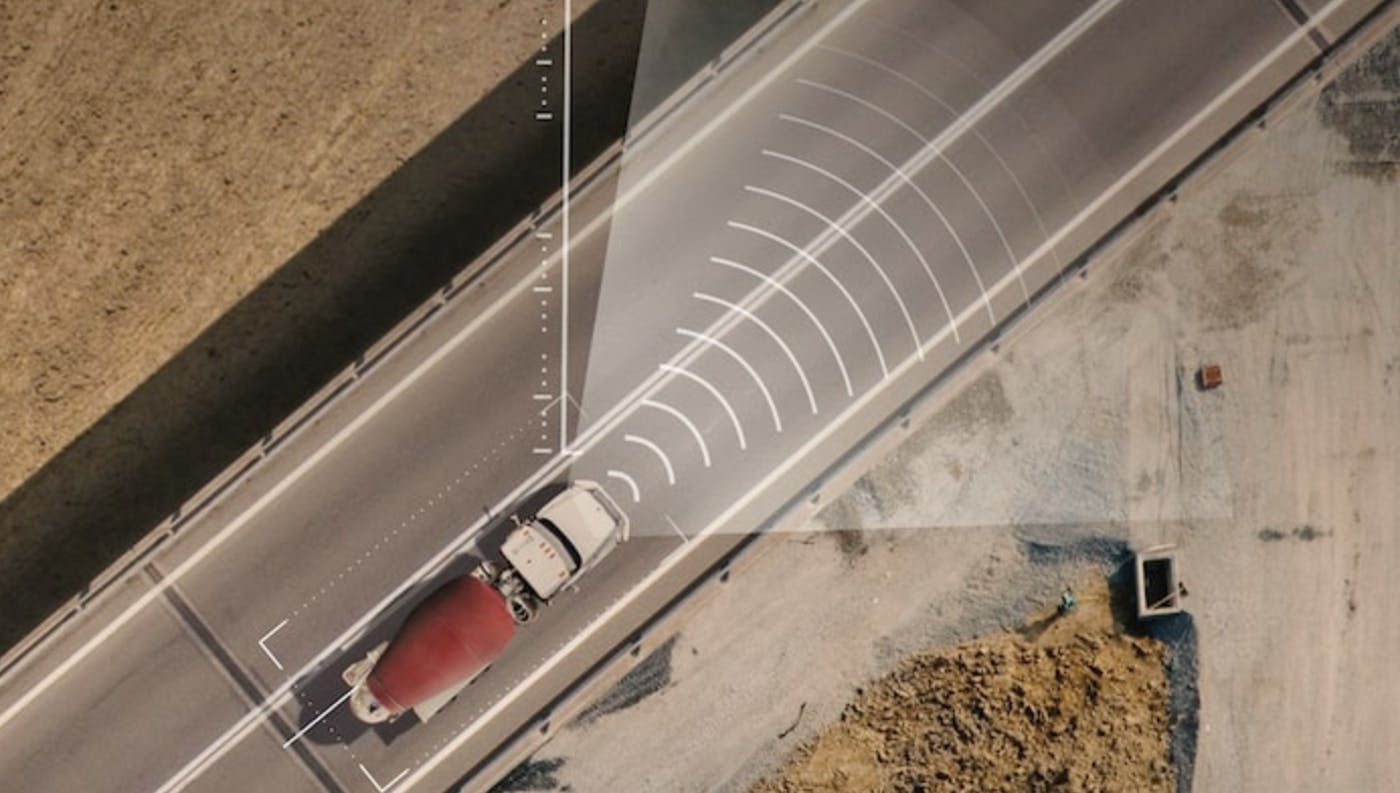
Mack Granite trucks are available with the next generation of Bendix Wingman Fusion, a camera- and radar-based driving assistance solution.Mack TrucksMack’s optional ADAS is the latest generation of Bendix Wingman Fusion. Mack Command Steer for the Granite axle-back model uses an electric motor to complement the steering’s hydraulics. Steering effort is reduced by up to 85% and helps the driver maintain a consistent course in strong winds, on rough roads and in other challenging conditions.
Keeping electronic systems current requires updates, and Mack Over the Air (OTA) remote programming allows drivers to perform updates through the truck’s instrument cluster at whatever time is most convenient.
Standard on Anthem and Pinnacle tractors and Granite construction models, “driver-activated OTA updates can be done in minutes without a visit to the dealer to receive software updates and set vehicle parameters,” says Wrinkle.
Assist technologies available on the Kenworth T680 Next Gen include lane-departure warning and Lane Keeping Assist. Lane departure uses an audible alert while Lane Keeping Assist provides a tactile alert through the steering wheel.
The T689 is also available with adaptive cruise control that monitors traffic conditions and modulates throttle and brake positions to maintain a pre-set following distance to the vehicle ahead.
Kenworth’s Side Object Detection continuously monitors the passenger side of the truck and provides audible and visual alerts when an object or vehicle has entered certain zones.
Covid lingers
Covid is still playing a major role in the trucking world.
“Economic strength has continued despite ongoing Covid disruptions,” says Jonathan Randall, Mack Truck senior vice president of sales and commercial operations. Consumer spending and residential construction have contributed to robust customer demand, increasing lead times and order backlogs.
However, there’s a bottleneck of goods at ports, and although freight pricing is expected to remain high, carriers are having trouble recruiting drivers to expand their fleets.
Hillman says everyone needs to be prepared for ongoing delays of parts and products. Microchip availability is one example. Navistar, like everyone else, is having hiring challenges. His advice: “Try to adapt as best you can in an ambiguous environment.”
Tabel says lead times have gone from two months in pre-Covid days to nine to 12 months now. Chassis lead times are long. Body lead times are also long, and costs vary frequently, sometimes day-by-day.
“Everything is in demand, and everything is in short supply,” he says. “It’s just the way things are for the time being.”
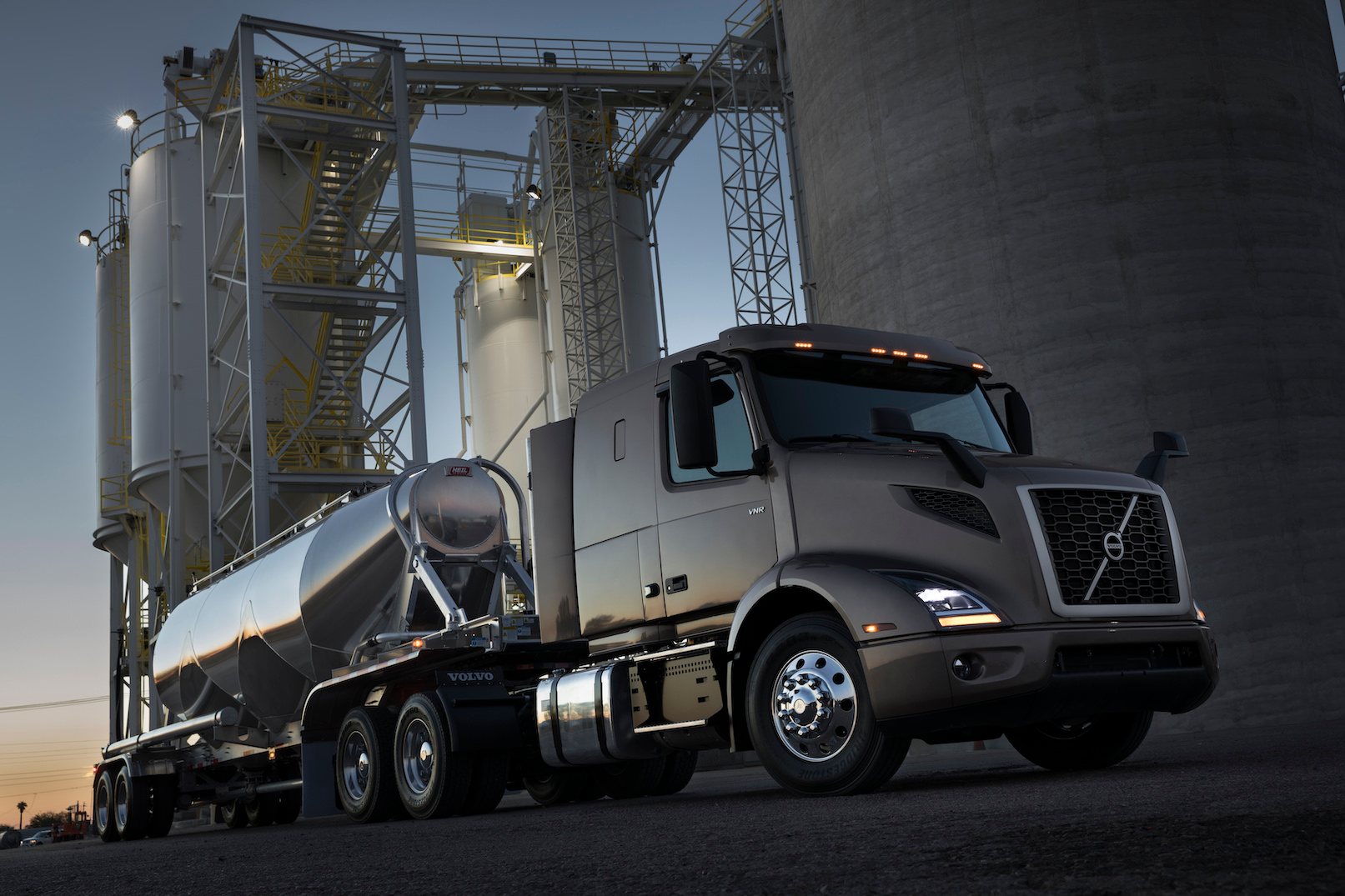
The Volvo VNR 400 has a 42-inch flat-roof sleeper to maintain hours of service on short hauls. Engine options are a Volvo D11 with up to 425 horsepower and 1,550 pound-feet of torque, or a Volvo D13 with up to 500 horsepower and 1,850 pound-feet. Transmission options are Eaton Fuller manuals of 10-, 13- or 18-speed; or Volvo I-Shift 12-speed, I-Shift 12-speed severe duty or I-Shift 13- or 14-speed with crawler.Volvo
Massive I-80 Project Prepares to Take Off for Largest U.S. Inland Port
Advance construction on a $1.2 billion interstate project to improve access to North America’s largest inland port is underway.
The rebuild of 16 miles of Interstate 80 in Will County is expected to take six years. The 50-year-old section is part of one of only three coast-to-coast interstates in the U.S. and sees 80,000 vehicles a day, with trucks making up one-fourth of that traffic, according to the Illinois Department of Transportation.
“With demand for freight projected to double in northeastern Illinois the next 20 years, Will County’s role as a transportation hub and the country’s largest inland port is critical,” said Illinois Transportation Secretary Omer Osman.
Advance work on I-80 began in June with a $47 million project to replace several bridges in Joliet, Rockdale and New Lenox and widen a section of the interstate. This project will reconstruct the U.S. 30 interchange, adding a third I-80 lane in each direction west from Interstate 355. Ahead of the Thanksgiving holiday, a third lane on Interstate 80 was opened in both directions in New Lenox as part of this project.
To speed up the I-80 rebuild, IDOT plans for construction, land acquisition and final engineering on sections to occur simultaneously. A section from Ridge Road to the DuPage River will be under construction starting next year, while land acquisition progresses and final engineering is completed on replacing the Des Plaines River bridges, IDOT says. In 2023, work will shift to the section between Ridge Road and U.S. 30. Construction of the Des Plaines River bridges and Center Street and U.S. 52/Illinois 53 (Chicago Street) interchanges will take place in 2026 and 2027.

The planned construction phases for the $1.2 billion, six-year I-80 rebuild project in Illinois.Illinois DOT
When it wraps up in 2027, the overall I-80 project will have:
Redesigned and rebuilt 16 miles.Added or extended auxiliary lanes to improve safety and reduce congestion.Rebuilt or improved Interchanges at Interstate 55, Illinois 7, Center Street, Chicago Street, Richards Street and Briggs Street.Built a new flyover ramp linking southbound I-55 to westbound I-80 to improve traffic flow and safety. Rehabilitated or replaced more than 30 bridges.Built 8 miles of sound walls to protect nearby neighborhoods from traffic noise.Built bike and pedestrian paths.
“These overdue improvements will not only make it safer for commercial drivers, but for the thousands of families who rely on I-80 to commute to work, drive their kids to school and move safely through their daily lives,” said Governor JB Pritzker.
The I-80 project is being funded by Rebuild Illinois, the largest capital program in the state’s history. The $33.2 billion program was enacted in 2019, and the state’s gas tax was doubled to pay for it. The program focuses not only on roads and bridges but transit, waterways, freight and passenger rail, aviation, and biking and walking traffic, according to IDOT.
Did you miss our previous article…
https://constructionosa.org/?p=1082
A Dozer from Doosan?: Here’s the Sneak Peek (Video)
Known primarily in the U.S. for its excavators and wheel loaders, Doosan is entering new territory in construction equipment with its first ever dozers.
Also unusual for the South Korean company is that the new dozers will make their world market debut in the U.S.
Doosan unveiled a “pre-prototype” of the DD100 dozer recently at the company’s testing grounds near Tucson, Arizona. (A video of the dozer in action can be seen at the end of this story.)
The dozers are being developed and built in South Korea and will be shipped to the United States. A 10-ton model is expected to arrive in the third quarter next year. A 13-ton model is slated for mid-2023.
“It’s something dealers have asked for, to help expand their business and help with their rental fleets,” said Aaron Kleingartner, Doosan product and dealer marketing manager, during a media event in Arizona. “We’re excited to see what this particular product category can do for us.”
Preliminary specs on the DD100 dozer are likely to change, but so far it runs on a 122-horsepower Doosan diesel engine that does not use a diesel particulate filter.
The company hopes to capture a portion of the $2.1 billion U.S. dozer market, 45% of which is made up of machines under 140 horsepower, Kleingartner says. The dozer additions will also give Doosan dealers and their customers a “one-stop shop” for their construction equipment needs, he said.

Doosan’s DD100 prototype dozer has a 122-horsepower engine with no diesel particulate filter.DoosanKleingartner summed up the company’s goals for the new dozers:
“We want to make sure we have low maintenance costs, superior power and traction, excellent visibility, and safe and easy operation. Those things are all going to be the requirements for us to be able to provide the opportunity for our customers to make the switch into this new product category.”
The cab, with lots of glass for better visibility, will be similiar to the company’s new line of excavators and wheel loaders. Controls will also be similar. Visibility is further increased by a narrow front engine box, and Doosan hid the air-intake pre-cleaner under the hood so it won’t block the operator’s view.
Other standard features include an 8-inch touchscreen display, rearview camera, front and rear LED lights, and rear side wiper blades. It will have keyless entry and push start.
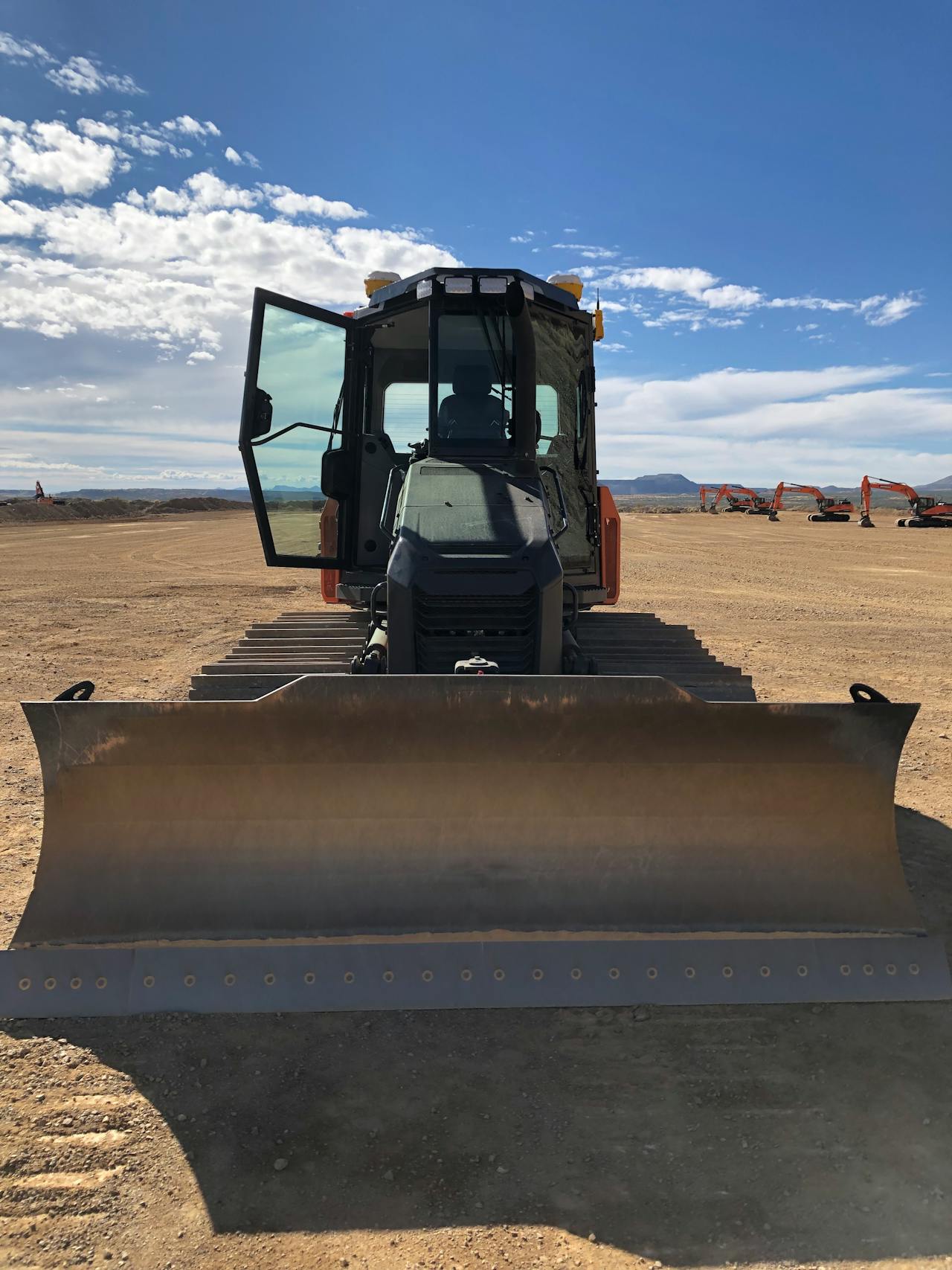
Doosan sought to improve operator visibility with lots of glass and by moving the air-intake pre-cleaner under the hood.Equipment WorldThe dozer blade will be six-angle, variable pitch. The standard blade will have a capacity of 2.9 cubic yards, and for the LGP model, 3.4 cubic yards.
The company says it has an agreement with Trimble to install mastless 3D machine control as an option. The controls will be standard electro-hydraulic, and the operator will be able to adjust control speed.
Mooyoung Park, Doosan engineering manager, said Doosan was mindful of the U.S. labor shortage and is designing the dozers to be easy and comfortable to operate. Safety features include a seat with an automatic cut-off sensor, so when the operator stands up, the machine will stop.

Doosan hopes to capture a share of the under-140-horsepower dozer market with new models for 2022 and 2023.DoosanThe DD100 model, which the company rolled out at its Arizona testing grounds, is expected to undergo changes in the development process before mass production.
The concept model was a low ground pressure version weighing 25,000 pounds. The standard model will weigh about 22,000.
“So our machine is a little bit heavier than the competition, and being a heavier machine,” Park said, “you’ll have more tractive effort to accommodate the power.”
Other preliminary specs on the DD100 prototype:
Blade height: 3 ft. 7 in. Blade width: 8 ft. 10 in. Blade angle: 22.5 degreesDrawbar pull: 33,721 pound-feetTrack length: 7 ft. 7 in.Travel speed, max: 5.7 mph
Contractor of the Year Finalist: W.F. Delauter Grows from One Dozer to 135-Piece Fleet
Kirby Delauter’s father, Russ, jokingly refers to the firm he and his father, Willie, formed in 1955 as a “one-horse operation.” Change that from one horse to one dozer, which the father-son team used to perform residential and commercial grading.

Now, far from that one-dozer start, the company is run by third-generation Kirby Delauter and his wife, Tina Delauter. The $10 million to $12 million firm does a variety of work including site development, demolition, utilities, bridges and stormwater management in three states.
Kirby’s entering the firm wasn’t necessarily a done deal, however. After serving six years in the U.S. Army, “I didn’t know what I wanted to do, and I didn’t think I was college material,” Kirby recalls. He joined the family firm and proved so adept he became president in 1994.
And after working for several years outside the company, Kirby and Tina’s son William has joined the firm and is on his way to becoming the 66-year-old company’s fourth generation. A licensed civil engineer, William has “the education to take this as far as he wants to take it,” Kirby says.
“After being on the design side, now I’m getting more of the construction side,” William says. But keep in mind he did grow up working in the family business before college, and Kirby says he “knows what it’s like getting dirty in the ditches.”
Great Recession
Like many in this industry, the Great Recession hit the company hard. “It’s something I’ve never seen before,” Kirby says. “It took us from around 65 employees down to 16.”
“You just worked through it because that’s all you could do,” he adds. “You learned a lot of things that you’ll never find in a book.”
“That showed me more about what he’s made of than anything because he handled it in a way that I couldn’t have,” says Russ.
The experience has prompted an emphasis on measured, steady growth. “We could be three times the size we are right now,” Kirby says, “but I want to grow the company responsibly.” He expects the business to increase revenues to $13 million to $15 million this fiscal year, which ends in March.
Sharp eye
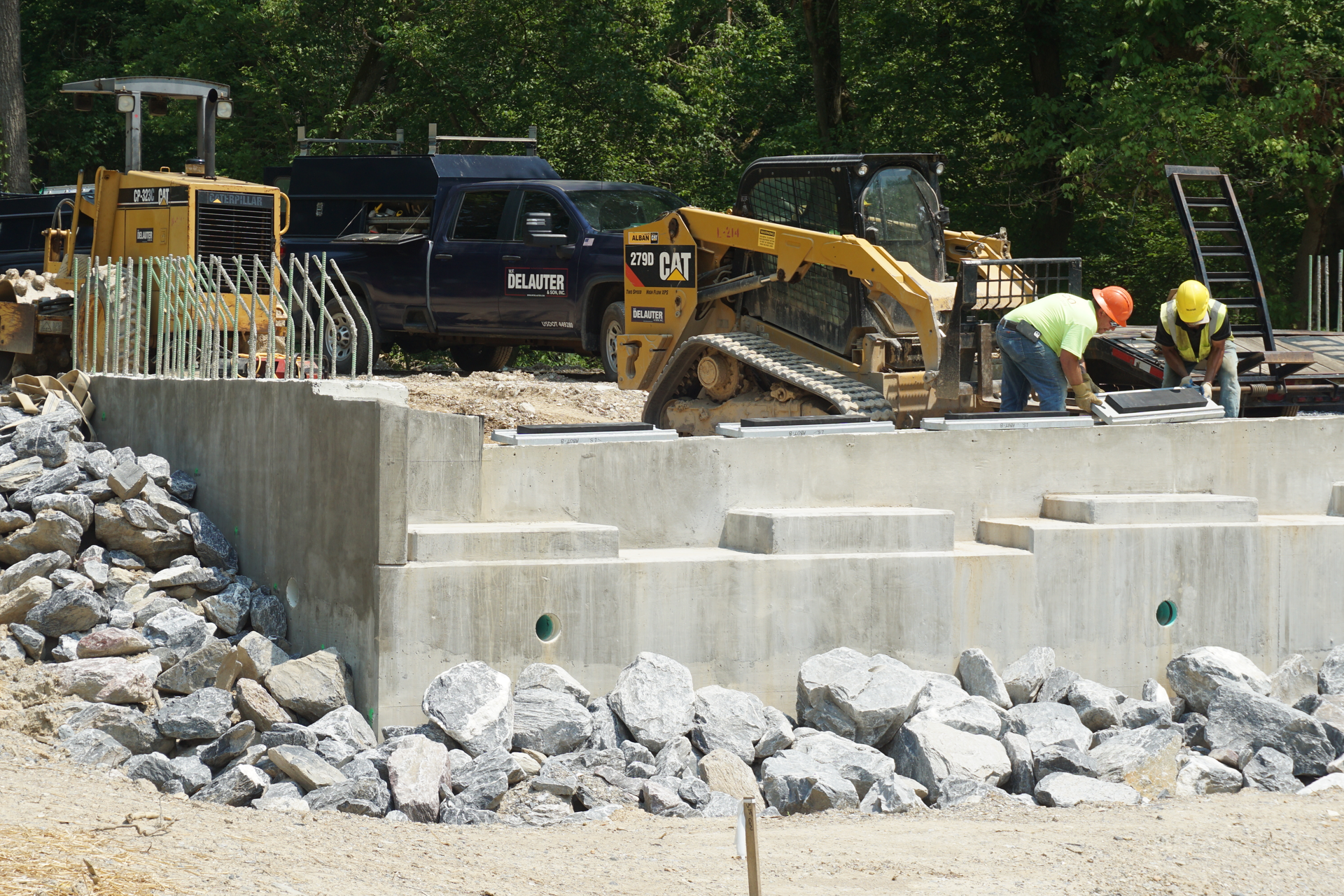
W. F. Delauter crews on the $3.6 million Gas House Pike Bridge in Frederick, Maryland.Equipment WorldPart of that responsible growth is keeping a sharp eye on equipment needs. “We run a little leaner now,” Kirby says. “If we don’t need something, I may sell it and then think about renting it.”
Kirby frequently uses RPOs and buys used if it’s a machine he expects to put less than 1,000 hours a year on. “Excavators, loaders and dozers are our frontline pieces, so I’m either going to buy them new or low-hour used,” Kirby says. The firm has around 135 major pieces of equipment.
In addition to the heavy machines, W.F. Delauter has seven compact track loaders. “They’re powerful and they get the job done,” Kirby says. “With a blade on them, you can sometimes use them as a default for a D4. It won’t push as much, but it gets around better. And we’ve had zero problems with them.”
Clients notice the appearance of W.F. Delauter machines on their jobsites. “His equipment is always in tip-top shape,” says Vinny Flook, owner of Vinny’s Towing, who has done several projects with the company.
The company has three full time mechanics, including one who specializes in engines. “We do most of our work in-house, such as reinstalling refurbished undercarriages,” Kirby says. A fuel/lube truck services the company’s jobs.
Learning that a local college had a Cat simulator but no instructor, Kirby raised his hand and taught equipment operation evenings and weekends this past semester. He took the students to one of his jobsites where they spent eight weeks operating equipment.
“All of the students passed the class,” Kirby says. He didn’t stop there: he helped them create resumes and gave them contacts. All found employment at $22 to $24 an hour within weeks of completing the course.
Tina joined Kirby in the office around eight years ago and handles business development, HR and manages the company’s 60-construction-dumpster roll-off division. The division developed out of W.F. Delauter’s need to haul construction debris off its own sites and now generates about $700,000 a year.
“We’re also looking at marketing recycled construction materials to other contractors,” Tina says.
Family first
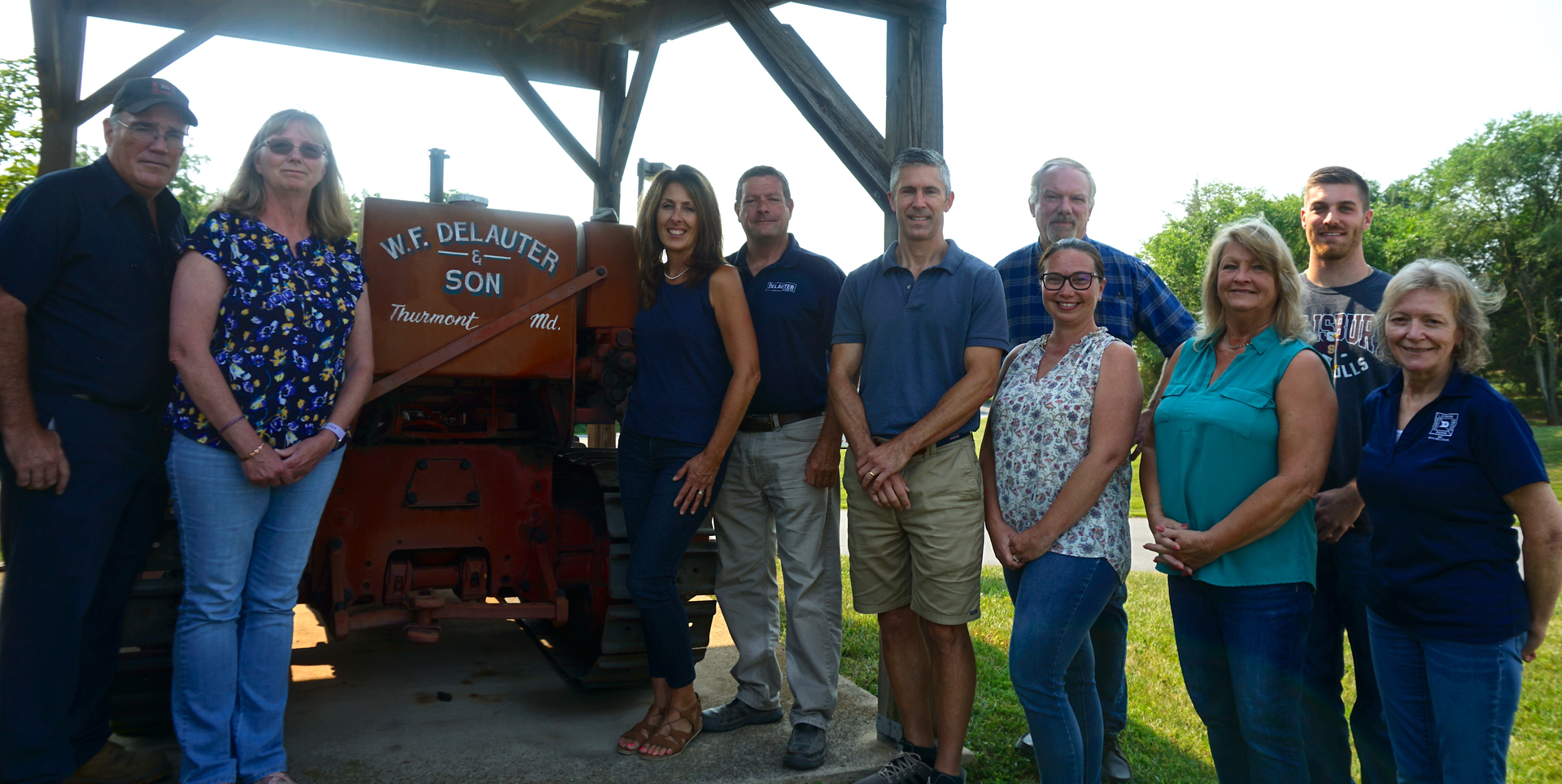
The International TD6 dozer that Willie and Russ Delauter used when starting W.F. Delauter now sits at the entrance to the firm and serves as the backdrop in this company photo.Equipment WorldThe company has around 70 employees, including five utility crews, two grading crews and a concrete crew. “I’ve always felt that good people attract good people,” Kirby says.
“We feel that family comes first,” Tina says. “I think that gives them an incentive to stick with us. And once you feel like you’re part of the team, you’re locked in with the group. We always tell them there’s room to grow. You might be a laborer now, but if you can jump on the backhoe and learn, for example, there’s a lot of potential to grow.”
Tina and Kirby also keep an eye on local labor rates, Kirby says. “I ask myself, ‘Are we going to keep good people and do people believe in us enough to sustain that?’” he says.
“It’s really been an honor for us to continue the legacy that Russ and Willie built from the ground up,” Tina says.
Client appreciation
You get a sense of both the legacy and the future of W.F. Delauter when you talk to its clients.
“They always stand behind their word,” says client Steve Oder with Cavalier Development. “I could do a handshake contract with them and be perfectly comfortable. There’s not many of those around anymore.”
“Concerns were quickly put to rest after seeing how conscientious, knowledgeable and skilled [their] employees were throughout the duration of the project,” says Gale Engles, bureau chief for the Carroll County, Maryland, Bureau of Resource Management.
“One thing that’s really impressed me, especially considering the size of his business, is how much he’s available and how responsive he is,” Flook says. “If it comes out his mouth, it’s golden.”
Did you miss our previous article…
https://constructionosa.org/?p=1069